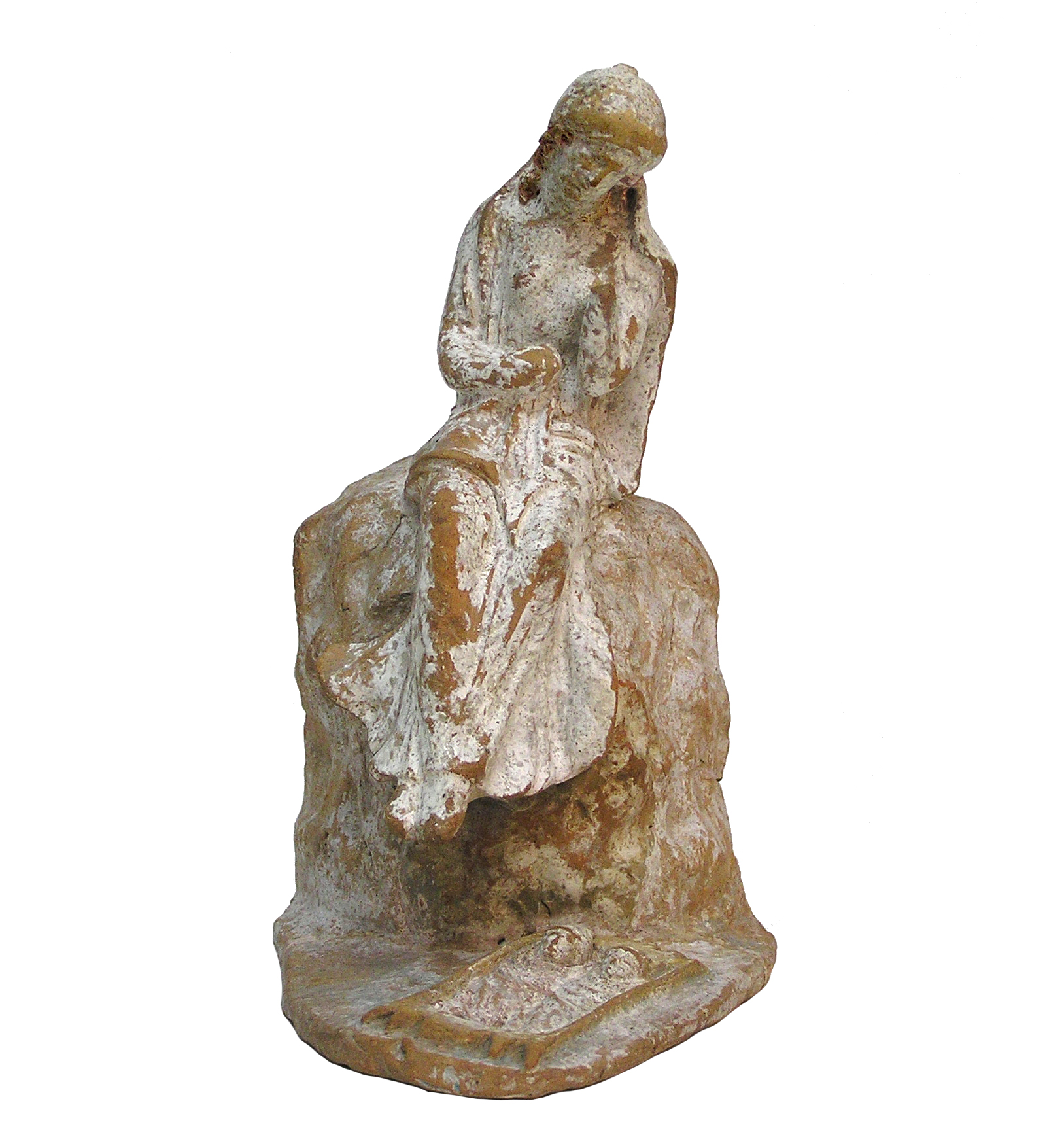Exhibit of the month
The unappeased lust of Tyro for the river Enipeus
Statuette of Tyro exposing her children
Hellenic National Archaeological Museum, Athens
Collection of terracotta figurines, inv. no. Α 4721
Provenance: Tanagra
Dimensions: Height 0,18 εκ.
Date: 300-250 BCE
Display place: Room 58, Showcase 14
The statuette depicts the myth of the Thessalian princess Tyro[1], who fell passionately in love with the river Enipeus, the most beautiful of the rivers that flowed upon the earth. Her persistent attempts to seduce him aroused the desire and envy of Poseidon, who assumed the form of Enipeus and ravished Tyro at the mouth of the river. Out of this union were born Pelias and Neleus.
The figurine represents the moment when the unmarried mother, seated on a rock, watches her swaddled newborn sons, exposed on the waters of the river, as they float away in a cradle. The left arm of the young woman is bent and raised to her face, in a gesture of fear and deep sorrow, while her right arm is folded over her stomach. In the myth, Pelias and Neleus are eventually saved by a herdsman, who raises them with his wife. Years later, the cradle would help the children to identify each other and reunite them with their family[2].
Sophocles put Tyro at the center of two tragedies that unfortunately did not survive. However, an indication of Tyro’s[3] tragic fate is found in Aristophanes’ Lysistrata in the phrase “Poseidon and cradle”[4] (Ποσειδῶν καὶ σκάφη). The cradle, the ark of salvation for her children, could also be seen as a symbol of the difficult path and the mental anguish of Tyro, who has been penalized by exile from society. The seduction and, in essence, her rape by Poseidon ultimately acted as a catalyst to restore the social order that had been disturbed by Τyro’s assuming the male role of sexual pursuer toward Enipeus.
The notorious for its beauty river Enipeus[5] forms the core of the mythological episode. Probably, in his beginnings he was a river god or a local hero, but over time, with the predominance of the twelve gods, he was relegated to a secondary deity. A life-giving force itself, it creates an orgiastic nature around its banks[6] which is the loving/safe environment for the fertilizing union of human with the divine, in a perpetual rebirth.
[1] Tyro is the first of the women that Odysseus encounters in Hades at Nekyia (Hom., Od., l, 235 ff.). For Tyro see Apoll., 1.9.8. Diodorus S., IV, 68.1. Lucian, Dialogues of the sea gods 13. Hesych., Quotes 30. Liv., Pre-Gymnasmata II, 39. Men., Epitrepontes 150 et seq. Commentator of Homer: Il. K, 334. Aelian., Varia Storia XII, 42.
[2] Tyros’ stepmother, Sidero, was a cruel person who tormented the noblewoman. She even kicked her out of her palace. When Tyros’ two sons grew up, they learned the truth about their decent and searched for their mother.
When they found her, particularly troubled, they learned of the suffering caused by her stepmother and they sought revenge. Sidero fled to the temple of Hera, as a supplicant. Peleus, however, did not respect the sacred space and, ignoring the wrath of the goddess, killed her. For this sacrilege, he was later severely punished. His own daughters slaughtered him when he was old, because they were misled by the words of the witch Medea, that in that way he could become young again.
[3] Under the name Tyro, Sophocles wrote two tragedies, which, have not been preserved, Tyro Anagnorizomeni and Tyro Keiromeni.
[4] This phrase is interpreted by the Commentator of the work as fornicating and giving birth (συνουσιάζειν και τίκτειν) (Commentator of Aristophanes: Lysistrata 138), possibly summarizing the way the male audience received the essence of the myth.
[5]The name is given in three rivers. One flows into Pieria, the other is a large tributary of the Penios in Thessaly, and the third, the small tributary of Alpheios, west of Olympia (Str. 8, 3, 32).
[6] The river Enipeas that rains the Thessalian land, endows it with an impressive riparian vegetation but also constitutes a nest of life of many species of faunas.
Dr Efi Oikonomou
Selected Bibliography:
S. Besques, Figurines et reliefs grecs en terre cuite III, Paris 1994, p. 10, pl. 7c.
P. Wolters, Tyro, Jb 6 (1891), pp. 61-63, Taf. 2.
Fr. Koepp, Terracottagruppe aus Tanagra, Ath. Mitt. X (1885), pp. 173-174.
Α. Chaniotis – N. Kaltsas – Ι. Mylonopoulos (ed.), A world of Emotions: Ancient Greece, 700 BC-200 BC, New York 2017, no. 43, p. 123 (E. Oikonomou)
M. Tiverios, Κειρομένη Τυρώ, όχι Μελανίππη, Logeion 7 (2017), 67-85.
https://www.naturagraeca.com/ws/214,278,283,1,1,%CE%95%CE%BD%CE%B9%CF%80%CE%AD%CE%B1%CF%82-%CE%98%CE%B5%CF%83%CF%83%CE%B1%CE%BB%CE%AF%CE%B1%CF%82


